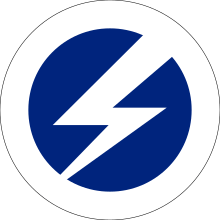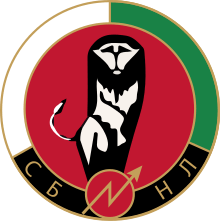Flash and circle
The flash and circle is a political symbol used by several organisations. It was first used by the British Union of Fascists (BUF), and was adopted in 1935.
.svg.png)
.svg.png)


The BUF's left-wing opponents nicknamed the symbol "the flash in the pan".[1]

The insignia of Singapore's People's Action Party (PAP) is composed of a red flash struck through a smaller blue circle on a white background. The PAP insignia is claimed to represent "action within social/racial unity" with the white background representing purity in thought and deed.[2]

The emblem of the Bulgarian fascist party, Union of Bulgarian National Legions (SBNL) had a modified version of flash and circle.
Similar non-political symbols
The simple combination of the lightning bolt and circle elements appears to have led to many similar designs unrelated to the flash and circle. These include the logo of BoltBus, which was chosen before the similarity was chosen.[3] One form of warning sign for high-voltage electricity uses a lightning bolt inside a circle, and this was repurposed by Marilyn Manson as an insignia for his album Antichrist Superstar.[4] In most cases, there is no evidence to suggest that the designer intended to evoke an association with political use of the symbol. German automobile manufacturer, Opel uses flash and circle as company logo.
References
- Benewick, Robert (1969), Political Violence & Public Order: A Study of British Fascism, p. 139
- Drysdale, John (1984), Singapore: Struggle for Success, p. 80
- Hopper, Tristin (January 28, 2016). "Fascist, schmaschist: Why a West Coast bus company picked the same logo as some dead British fascists". The National Post. Retrieved January 13, 2020.
- Baddeley, Gavin (2001). Dissecting Marilyn Manson. London: Plexus Publishing. pp. 101–102. ISBN 0859653722 – via GoogleBooks.
The insignia that represents the Antichrist Superstar album ... also echoes the insignia of Oswald Moseley's British Union of Fascists...